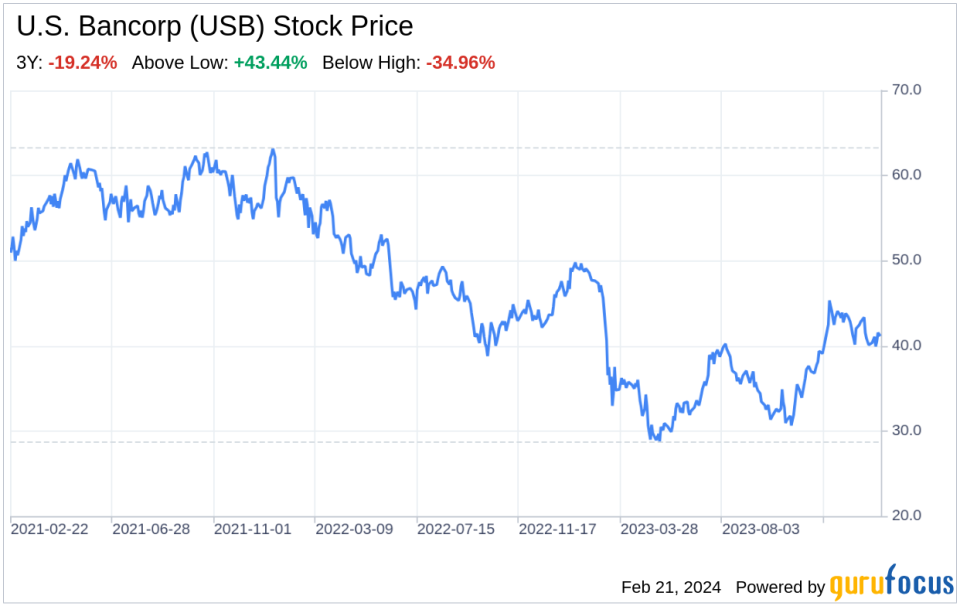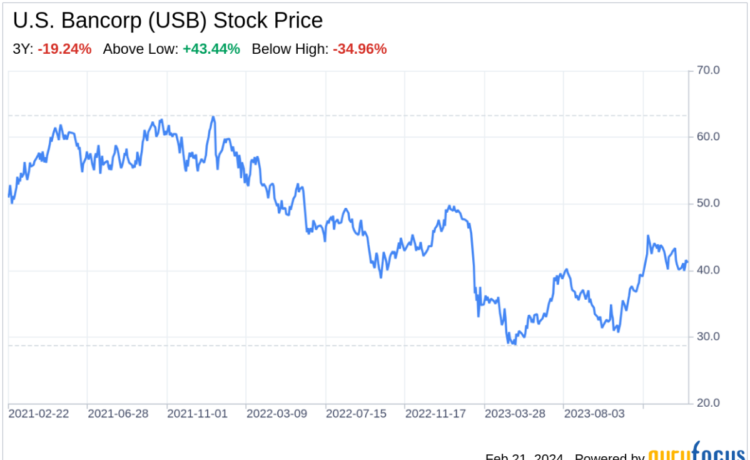-
U.S. Bancorp’s robust financial performance and strategic acquisitions position it as a formidable player in the financial sector.
-
Despite strong market presence, the company faces challenges from economic fluctuations and increasing competition.
-
Opportunities for growth through digital transformation and market expansion are counterbalanced by regulatory pressures and cybersecurity threats.
-
Strategic initiatives and a focus on customer-centric services could mitigate risks and leverage potential market opportunities.
On February 20, 2024, U.S. Bancorp (NYSE:USB), a leading diversified financial-services provider, filed its 10-K report, revealing a comprehensive overview of its operations and financial health. With a network of 2,274 banking offices and $512.3 billion in consolidated deposits as of December 31, 2023, U.S. Bancorp stands as a significant entity in the Western and Midwestern United States. The company’s financial tables show a robust balance sheet, with notable increases in net income across its Consumer and Business Banking segments by 20.6% compared to the previous year. However, the Payment Services segment experienced an 11.2% decrease in net income. This SWOT analysis delves into the strengths, weaknesses, opportunities, and threats as disclosed in the 10-K filing, providing investors with a nuanced understanding of U.S. Bancorp’s market position and strategic direction.


Strengths
Brand Power and Market Presence: U.S. Bancorp’s strong brand and significant market presence are key strengths. With a history of stable financial performance and strategic acquisitions, such as the recent purchase of MUFG Union Bank, the company has solidified its position in the financial sector. The acquisition not only expanded its customer base but also enhanced its product offerings, contributing to a 6.0% increase in net income for its Wealth, Corporate, Commercial, and Institutional Banking segment in 2023. U.S. Bancorp’s reputation for reliability and customer service continues to attract and retain customers, reinforcing its competitive edge.
Digital Banking Capabilities: The company’s investment in digital banking services has paid off, with a significant percentage of consumer transactions now completed online or through its digital app. This focus on technology has improved customer convenience and operational efficiency, positioning U.S. Bancorp favorably against competitors who may be slower to adopt digital innovations. The company’s network of 4,524 ATMs and 24-hour customer service further supports its strength in accessibility and customer engagement.
Weaknesses
Sensitivity to Economic Fluctuations: U.S. Bancorp’s performance is closely tied to the broader economic environment. Factors such as interest rate changes, unemployment rates, and credit quality can significantly impact the company’s revenues and asset values. The 10-K filing acknowledges these vulnerabilities, noting the potential for adverse effects on the bank’s financial stability during economic downturns. This sensitivity underscores the need for prudent risk management and diversified revenue streams to buffer against economic headwinds.
Regulatory Compliance Burden: The financial industry’s regulatory landscape is complex and ever-changing. U.S. Bancorp’s 10-K filing highlights the challenges of adapting to new regulatory requirements, which can be resource-intensive and restrict operational flexibility. The company’s ability to satisfy these requirements is critical to its continued success, but the associated costs and efforts represent a significant weakness that requires ongoing attention and strategic planning.
Opportunities
Expansion through Technological Innovation: U.S. Bancorp is well-positioned to capitalize on the growing demand for digital financial services. By continuing to invest in and develop its digital platforms, the company can attract tech-savvy customers and create new revenue streams. The rise of mobile payments, digital wallets, and digital currencies presents an opportunity for U.S. Bancorp to lead in innovation and expand its market share in the digital space.
Market Expansion and Diversification: The acquisition of MUFG Union Bank opens new markets and customer segments for U.S. Bancorp. This strategic move not only diversifies the company’s portfolio but also provides opportunities for cross-selling and enhanced service offerings. By leveraging its expanded footprint and comprehensive financial services, U.S. Bancorp can capture additional market share and drive growth.
Threats
Competitive Pressure from Fintechs: The rise of financial technology companies, or fintechs, poses a significant threat to traditional banking institutions like U.S. Bancorp. Fintechs often operate with greater agility and fewer regulatory constraints, enabling them to offer competitive, innovative products quickly. U.S. Bancorp must continue to innovate and adapt to maintain its competitive position in the face of this growing challenge.
Cybersecurity Risks: In an increasingly digital world, the threat of data breaches and cyber-attacks is a constant concern. U.S. Bancorp acknowledges the importance of robust cybersecurity measures to protect sensitive customer information and maintain trust. Any failure in the company’s security systems could lead to financial loss, reputational damage, and erosion of customer confidence, making cybersecurity a critical area of focus.
In conclusion, U.S. Bancorp’s SWOT analysis reveals a financial institution with a strong market presence and a commitment to digital innovation, poised to capitalize on growth opportunities. However, economic sensitivity and regulatory challenges present ongoing risks that require careful management. By leveraging its strengths and addressing its weaknesses, U.S. Bancorp can navigate the competitive landscape and harness opportunities for expansion and technological advancement. The company’s strategic focus on customer-centric services and operational efficiency will be crucial in mitigating threats and solidifying its position as a leader in the financial services industry.
This article, generated by GuruFocus, is designed to provide general insights and is not tailored financial advice. Our commentary is rooted in historical data and analyst projections, utilizing an impartial methodology, and is not intended to serve as specific investment guidance. It does not formulate a recommendation to purchase or divest any stock and does not consider individual investment objectives or financial circumstances. Our objective is to deliver long-term, fundamental data-driven analysis. Be aware that our analysis might not incorporate the most recent, price-sensitive company announcements or qualitative information. GuruFocus holds no position in the stocks mentioned herein.
This article first appeared on GuruFocus.

















